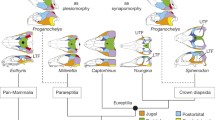Abstract.
Consensus on the evolutionary position of turtles within the amniote phylogeny has eluded evolutionary biologists for more than a century. This phylogenetic problem has remained unsolved partly because turtles have such a unique morphology that only few characters can be used to link them with any other group of amniotes. Among the many alternative hypotheses that have been postulated to explain the origin and phylogenetic relationships of turtles, a general agreement among paleontologists emerged in favoring the placement of turtles as the only living survivors of the anapsid reptiles (those that lack temporal fenestrae in the skull). However, recent morphological and molecular studies have radically changed our view of amniote phylogenetic relationships, and evidence is accumulating that supports the diapsid affinities of turtles. Molecular studies favor archosaurs (crocodiles and birds) as the living sister group of turtles, whereas morphological studies support lepidosaurs (tuatara, lizards, and snakes) as the closest living relatives of turtles. Accepting these hypotheses implies that turtles cannot be viewed any longer as primitive reptiles, and that they might have lost the temporal holes in the skull secondarily rather than never having had them.
Similar content being viewed by others
Author information
Authors and Affiliations
Additional information
Electronic Publication
Rights and permissions
About this article
Cite this article
Zardoya, R., Meyer, A. The evolutionary position of turtles revised. Naturwissenschaften 88, 193–200 (2001). https://doi.org/10.1007/s001140100228
Issue Date:
DOI: https://doi.org/10.1007/s001140100228



